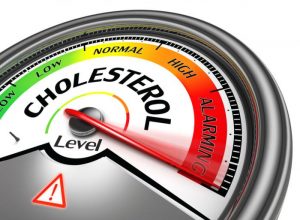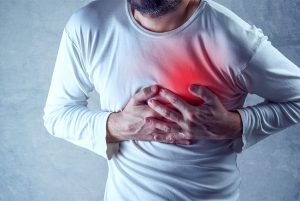
When you think about cholesterol, you probably automatically think of heart problems and bad health. But you should know that your body actually needs cholesterol to produce hormones and build cells. In fact, this fatty substance is produced in your liver and also helps in the production of bile. But some of the cholesterol in your blood comes from the food that you eat.
It is true, however, that high levels of cholesterol can become a problem, so it is a good idea to get to know more about it. There are three types of cholesterol: low-density lipoprotein (LDL), also known as bad cholesterol, high-density lipoprotein (HDL), which is known as good cholesterol, and triglycerides, a type of fat or lipid found in your blood. The total of all these is referred to as your total cholesterol.
Having high cholesterol levels can lead to heart problems, but the trouble is that it does not usually produce any detectable symptoms. You will need to get your blood checked to find out if you have high cholesterol.
Risk Factors of High Cholesterol
Your lifestyle plays a big role in your risk of getting high cholesterol. The following factors can increase your risk:
- A diet high in trans and saturated fats – Both of these kinds of fats increase LDL levels, while trans fats lower HDL cholesterol.
- An inactive lifestyle – Physical activity helps raise good HDL cholesterol while lowering LDL levels.
- Smoking – There are a lot of reasons to quit smoking, and one of these is the bad effect it has on your cholesterol levels. It lowers your good HDL cholesterol and also damages your blood vessels, which can make them more likely to store fatty deposits.
- Being overweight – Obesity has been found to affect the way cholesterol and glucose are metabolized by your body. It causes a greater production of cholesterol and a reduced breakdown of its particles.
- Age – Your liver becomes less efficient at removing bad LDL cholesterol from your blood as you grow older. That’s why most people with high cholesterol are diagnosed when they are already in their 40s and 50s.
- Menopause – Women generally have a lower risk of high cholesterol compared to men, but after menopause, their levels of estrogen decrease. This causes their total and LDL cholesterol levels to go up, increasing their risk of high cholesterol.
- Race – It is not clear why, but some races have been shown to be at a greater risk of higher cholesterol levels. Hispanic Americans have a greater chance of having low HDL cholesterol, while Asian Americans have a greater chance of having high LDL cholesterol. Non-Hispanic whites are more likely to have high total cholesterol, while black people have a greater chance of having other risk factors for heart problems despite having higher HDL levels.
- Genetics – A history of high cholesterol and heart problems in your family means that you are at a greater risk of developing high cholesterol.
Symptoms of High Cholesterol
As mentioned earlier, there are no detectable symptoms produced by high cholesterol. Even if you practice a healthy lifestyle with regular exercise and a healthy diet, you may still have high cholesterol levels and not even know it. The only way to keep track of your blood cholesterol is to get it checked regularly. This is especially important if you have a family history of high cholesterol, or if you have any related conditions such as heart disease or diabetes.
Diagnosis of High Cholesterol

Blood cholesterol is checked through a blood test called lipid panel. It measures the levels of total cholesterol, LDL cholesterol, HDL cholesterol and sometimes triglycerides in your blood. As with other blood work, you typically need to fast overnight before getting your blood drawn from an artery in your arm.
The healthy levels for these types of cholesterol are as follows: below 200 milligrams per deciliter for total cholesterol, below 100 mg/dL for LDL cholesterol, above 40 mg/dL for men and above 50 mg/dL for women for HDL cholesterol, and below 150 mg/dL for triglycerides.
Adults are advised by the Centers for Disease Control and Prevention (CDC) to get their blood cholesterol levels checked every four to six years. But if you have a family history of high cholesterol, or if you have a condition such as heart disease or diabetes, it is recommended to get checked more often.
Treatment for High Cholesterol
Although treatment may vary depending on your age and medical history, high cholesterol is typically treated with medication and lifestyle changes. Younger patients might only need to make changes to their lifestyle, but older ones with existing conditions may need to take medication as well.
If you have been diagnosed with high cholesterol, or even if you just suspect that you do, here are the steps you can take on your own:
- Eat a healthy diet. Avoid trans fats and saturated fats as much as possible. Plant based foods are the best options. They contain fiber, which can contribute to increasing your good HDL cholesterol.
- Get physically active. Regular physical activity has many health benefits. Try to get around 150 minutes of moderate activity or 75 minutes of vigorous activity per week, as recommended by the American Heart Association (AHA). You can consult with your doctor to find out what kind of exercise would be good for you and how much of it you should engage in.
- Quit smoking. Smoking can impact your cholesterol levels as well as other areas of your health. Quitting now can help improve your overall health.
- Maintain a healthy weight. Although being at a healthy weight does not guarantee having healthy cholesterol levels, being overweight may affect your blood cholesterol. It is still best for you to maintain a healthy weight.
Complications of High Cholesterol

Having high cholesterol puts you at risk of developing heart conditions. Fatty deposits can get in your arteries, which may lead to the buildup of plaque on the walls of the arteries, a condition known as atherosclerosis. This can cause your arteries to narrow, slowing down your blood flow. If this happens, parts of your body might be unable to get the oxygen and nutrients they need, putting you at risk of serious conditions, including the following:
- Peripheral Heart Disease – This occurs when the arteries outside your heart become narrow or blocked. When plaque builds up in these peripheral arteries that serve the head, arms, legs and stomach, it can cause pain and numbness.
- Cardiovascular Disease – Heart disease is the leading cause of death in the United States. The term covers different conditions that affect your heart or blood vessels.
- Heart Attack – This happens when the flow of blood to your heart is blocked, often caused by a buildup of fat, cholesterol or other substances, forming a plaque in your arteries. If this plaque ruptures, it can form a clot that blocks your blood flow, cutting off the flow of oxygen.
- Stroke – If the arteries leading to your brain become blocked, it can interrupt the supply of blood to your brain, which may lead to a stroke.
Prevention of High Cholesterol
Making healthy lifestyle changes can go a long way in preventing high cholesterol. The same changes recommended for those already suffering from high cholesterol can be adapted to lower your risk of even developing it in the first place.
The following habits can help you prevent getting high cholesterol:
- Eating a healthy diet – Increase the amount of plant-based foods in your diet, including vegetables, fruits, whole grains, nuts, seeds, beans and legumes. These foods can give you more fiber, which can affect your LDL and HDL cholesterol levels. Choose lean meat options, such as fish, poultry or lean cuts of beef. Avoid saturated and trans fats as much as possible, and instead opt for healthy fat sources such as avocado and olive oil.
- Engaging in regular exercise – Among many other health benefits, physical exercise can help lower your bad LDL cholesterol while boosting your HDL levels. Consult with your doctor to find out the best exercises for you.
- Quitting smoking – Smoking can affect your cholesterol levels. Quitting now can result in an increase of your HDL levels, as well as improved overall health.
- Maintaining a healthy weight – Losing some body weight may result in lower levels of total cholesterol, LDL cholesterol and triglycerides if you are overweight or obese. Get your doctor’s advice as to what weight range you should maintain.
It is better not to wait, and to stop high cholesterol before it even happens. Start making these lifestyle changes and you can look forward to better health.



